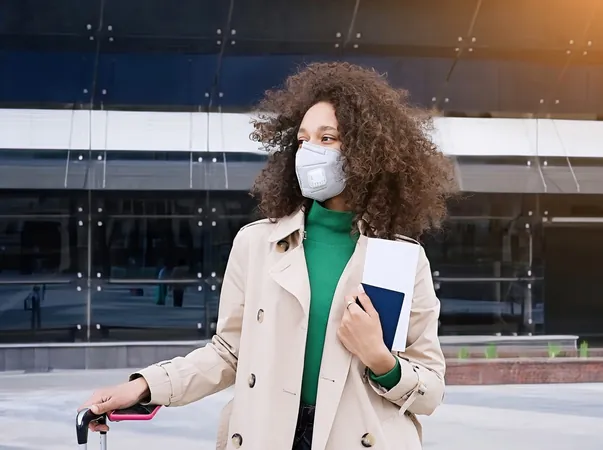
Preparing for the Next Pandemic: Key Lessons on Airborne Viral Transmission
2024-12-29
Author: Wei
The COVID-19 pandemic transformed our world dramatically. With masks, lockdowns, travel restrictions, and public health mandates becoming common in 2020, the effects were felt across health systems and economies globally. According to the World Health Organization, more than three million lives were taken by the virus in its first year alone, emphasizing the urgent need for preparedness against future outbreaks.
Now, five years later, a study led by Dr. Richard Sear at the University of Surrey illuminates how we can better ready ourselves for future respiratory diseases. This important research not only provides insights for managing future pandemics but also for addressing seasonal illnesses like the flu and respiratory syncytial virus (RSV).
Understanding Viral Transmission
Dr. Sear, an associate professor within Surrey’s School of Mathematics and Physics, focused on how airborne transmission contributes to the spread of COVID-19. By integrating data modeling with insights from the UK’s NHS COVID-19 app, his study assessed the efficacy of various health strategies, such as wearing masks and enhancing indoor ventilation.
“I aimed to understand how different strategies, including the use of face masks, affect the airborne transmission of viruses. This knowledge is not just valuable for potential future pandemics, but also for controlling seasonal outbreaks,” Dr. Sear explained.
The Power of High-Quality Masks
One finding of particular note indicates that high-quality masks, such as N95 or FFP2, prove to be immensely effective. When these masks are universally adopted, they can reduce transmission rates of COVID-19 by nearly ninefold. Even when worn individually, these masks diminish the risk of transmission by three times, regardless of how long contact may last. Conversely, surgical and cloth masks were found to be significantly less effective.
This underscores the necessity for health policies to prioritize the distribution and public use of high-quality masks, not only during pandemics but also in the management of seasonal respiratory challenges.
Enhancing Indoor Ventilation
Another critical aspect of Dr. Sear's research is the vital role of ventilation in curbing virus spread. Poorly ventilated spaces are breeding grounds for viral particles, particularly during activities like talking, coughing, or spending time in close proximity to others. The study indicated that improving indoor air turnover rates—be it through opening windows, optimizing air conditioning systems, or enhancing mechanical ventilation—can reduce transmission risk by up to 30%.
Furthermore, combining improved ventilation with physical distancing enhances protective effects, emphasizing a layered strategy against airborne viruses.
The Impact of Environmental and Behavioral Factors
The variability in viral transmission rates is influenced by numerous factors, ranging from viral load to individual susceptibility and environmental conditions. Certain interactions carry greater risk, highlighting the need for public health strategies that address both behavioral responses and environmental factors.
Dr. Sear commented, “The pandemic has taught us invaluable lessons about global health crises. It showcased our ability to rapidly develop vaccines and implement preventive strategies. As we move forward, we have the chance to leverage these lessons to better control respiratory diseases—not solely to protect against future pandemics but also to manage seasonal illnesses effectively.”
Comprehensive Strategies for Viral Transmission Reduction
The insights drawn from the COVID-19 experience stress the importance of preventive measures for controlling airborne diseases. Investment in high-quality masks, improvement of indoor air quality, and the promotion of behavioral changes such as distancing and masking during outbreaks can significantly lower viral transmission risks. Implementing these strategies can not only mitigate the impact of future pandemics but also enhance management of seasonal respiratory illnesses.
By adopting and applying these crucial findings, society can strengthen its defenses against the health and economic ramifications of airborne diseases. Dr. Sear’s study highlights the effectiveness of basic yet powerful interventions like wearing N95 masks and improving ventilation—simple measures that can make a tremendous difference in reducing virus transmission and ultimately saving lives.
The study is now published in the prestigious journal *Physical Review E*, providing a foundation for future research and public health strategies.
Stay informed: Subscribe to our newsletter for more insightful articles and the latest updates on health and science!


 Brasil (PT)
Brasil (PT)
 Canada (EN)
Canada (EN)
 Chile (ES)
Chile (ES)
 Česko (CS)
Česko (CS)
 대한민국 (KO)
대한민국 (KO)
 España (ES)
España (ES)
 France (FR)
France (FR)
 Hong Kong (EN)
Hong Kong (EN)
 Italia (IT)
Italia (IT)
 日本 (JA)
日本 (JA)
 Magyarország (HU)
Magyarország (HU)
 Norge (NO)
Norge (NO)
 Polska (PL)
Polska (PL)
 Schweiz (DE)
Schweiz (DE)
 Singapore (EN)
Singapore (EN)
 Sverige (SV)
Sverige (SV)
 Suomi (FI)
Suomi (FI)
 Türkiye (TR)
Türkiye (TR)
 الإمارات العربية المتحدة (AR)
الإمارات العربية المتحدة (AR)